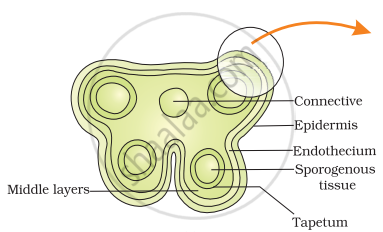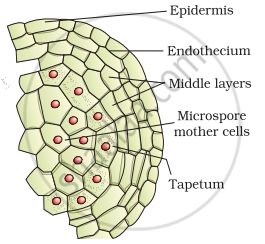Advertisements
Advertisements
Question
Draw the diagram of a microsporangium and label its wall layers. Write briefly on the role of the endothecium.
Solution
| (a) |  |
| (b) |  |
| (c) |  |
(a) Transverse section of a young anther; (b) Enlarged view of one microsporangium showing wall layers; (c) A mature dehisced anther
In a transverse section a typical microsporangium is circular in outline and is surrounded by four wall layers.
(a) Epidermis it is the epidermis is the outermost protective layer. It is composed of tangentially flattened cells. The cells are closely fitted and have thick walls which is helpful in the dehiscence of another.
(b) Endothecium it is present below the epidermis and expands radically with fibrous thickenings, at maturity these cells loose water, contract and help in the dehiscence of pollen sac.
(c) Well Layers it is present between well-marked endothecium and tapetum. These are thin-walled layers, arranged in one to five layers, which also help in the dehiscence of another.
(d) Tapetum it is the innermost wall layer with large cells, thin cell walls abundant cytoplasm and more than one nucid. Tapetum is a nutritive tissue which nourishes the developing pollen grains.
The centre of the microsporangium consists of sporogenous tissue which undergoes meiotic divisions to form microspore tetrads. This process is known as microsporogensis.
